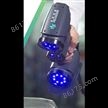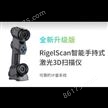电位滴定法测量Zeta电位和PH的关系
Potentiometric Titrations are useful for determining a sample's IEP. As mentioned above, the IEP may be desirable or otherwise. Potentiometric Titration plots may display plateau regions for Zeta potential vs. pH. Such measurements enable manufacturers to optimize use of acids or bases for transportation and storage. Figure 2 shows a potentiometric titration on a Ludox-TM silica sample by automatic addition of 1N HCl. This titration was performed automatically by a Zeta-APS, Zeta Acoustic Particle Sizer, instrument from Matec Applied Sciences, Northborough, MA USA 3. Figure 2 shows that below pH 4, the Zeta curve approaches a plateau region while Conductivity increases more rapidly. This suggests that the silica particles are becoming saturated with H+ ions as the pH is lowered. Conductivity increases more rapidly as more of these H+ ions stay in the continuous water solvent as opposed to diffusing through the slipping plane toward the particle surface.
电位滴定法可用于测定样品的等电点。如上所述,IEP可能是可取的或者相反。电位滴定图可以显示Zeta电位与pH值之间的关系变化。这样的测量使制造商通过酸或碱的使用,优化产品的运输和储存。图2显示在Ludox TM二氧化硅样品上自动添加1N HCl时,Zeta电位及电导率的变化。该过程是由美国MAS公司生产的超声电声法粒度及Zeta电位分析仪Zeta-APS设备完成的。图2显示,在pH<4时,Zeta曲线接近一个稳定区域,而电导率增加得更快。这表明,随着pH值的降低,二氧化硅颗粒逐渐被H+离子饱和。当更多的H+离子停留在连续的水溶剂中时,电导率增加得更快,而不是通过滑面向颗粒表面扩散。

图2通过自动电位滴定法将1N HCl加入到10%体积的Ludox TM二氧化硅溶液中
Figure 2. Automatic potentiometric titration of 10%-vol Ludox-TM by 1N HCl addition.
免责声明
- 凡本网注明“来源:仪器网”的所有作品,均为浙江兴旺宝明通网络有限公司-仪器网合法拥有版权或有权使用的作品,未经本网授权不得转载、摘编或利用其它方式使用上述作品。已经本网授权使用作品的,应在授权范围内使用,并注明“来源:仪器网”。违反上述声明者,本网将追究其相关法律责任。
- 本网转载并注明自其他来源(非仪器网)的作品,目的在于传递更多信息,并不代表本网赞同其观点和对其真实性负责,不承担此类作品侵权行为的直接责任及连带责任。其他媒体、网站或个人从本网转载时,必须保留本网注明的作品第一来源,并自负版权等法律责任。
- 如涉及作品内容、版权等问题,请在作品发表之日起一周内与本网联系,否则视为放弃相关权利。
 移动端
移动端






 回放
回放
 回放
回放




















 浙公网安备 33010602002722号
浙公网安备 33010602002722号
中国国际科学仪器及实验室装备展览会(CISILE)
展会城市:北京市展会时间:2026-05-29